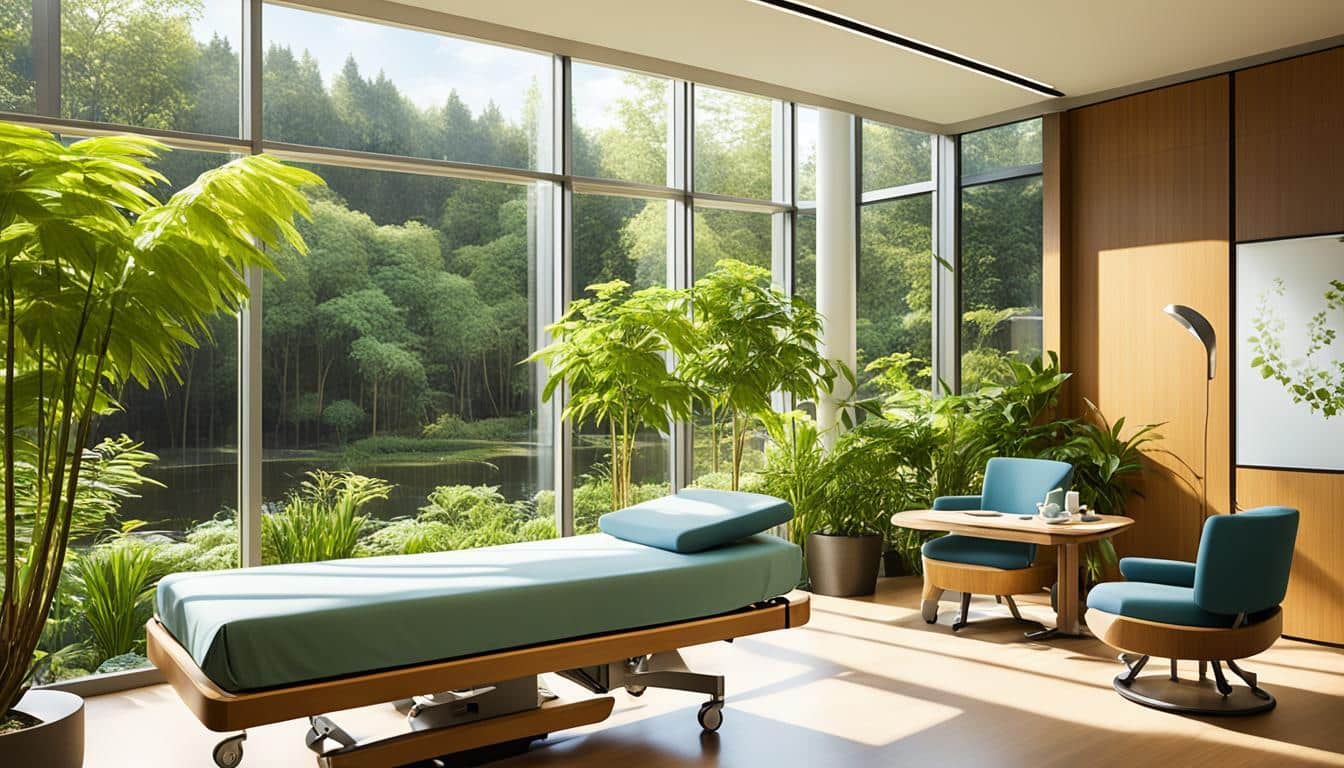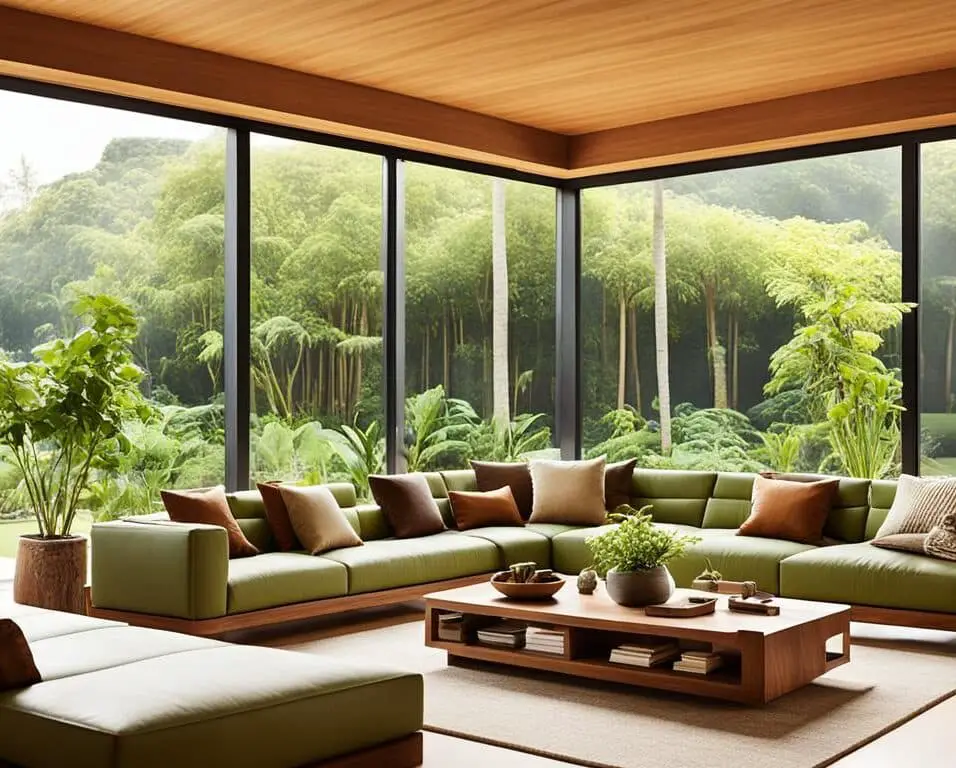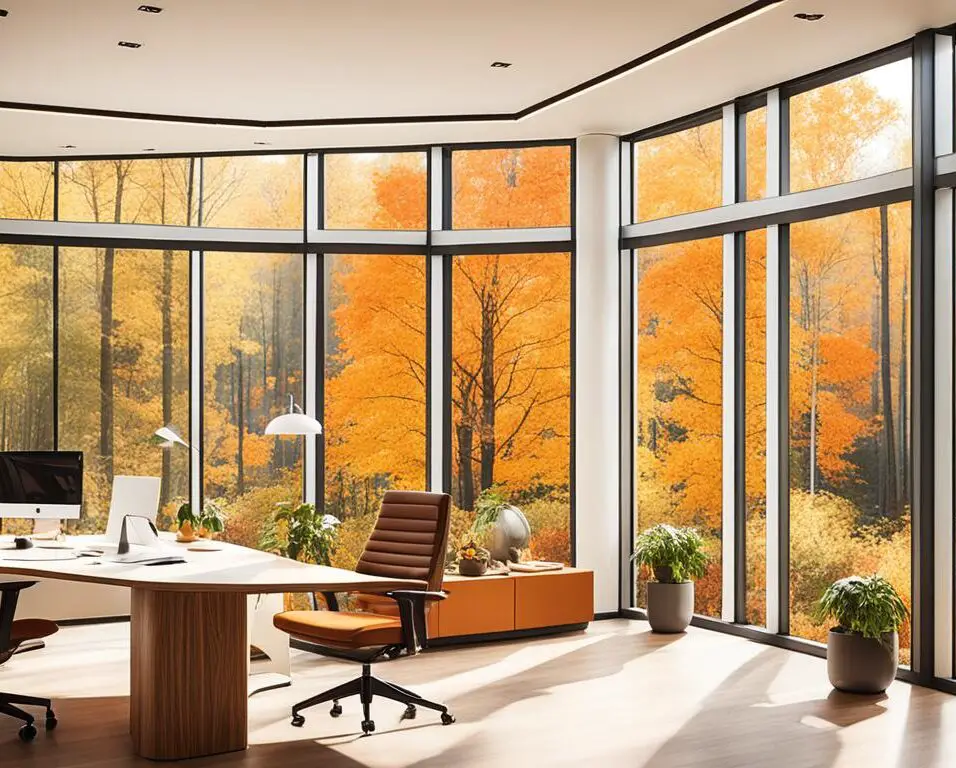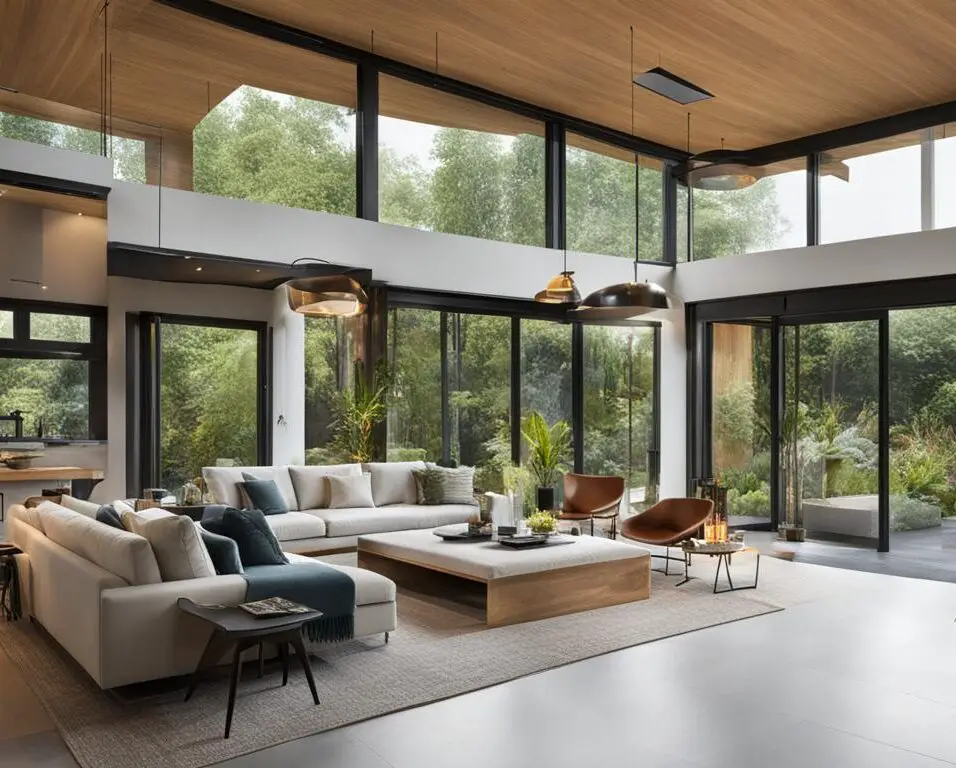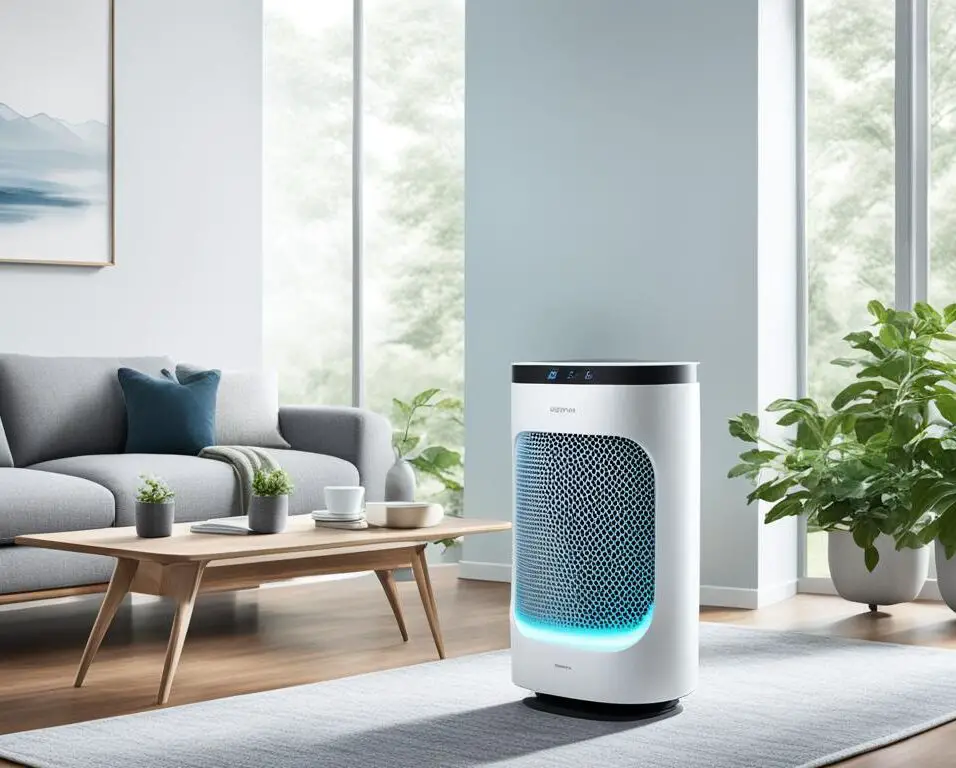Healing Environments: Biophilic Design in Healthcare Facilities
As a journalist, I have always been intrigued by the intersection of design and well-being, particularly in the context of healthcare facilities. In recent years, a concept known as biophilic design has gained traction in the industry, and its potential to improve patient healing and well-being is garnering attention. Biophilic design focuses on integrating elements of nature into healthcare spaces, creating healing environments that benefit both patients and staff.
Biophilic design encompasses various strategies, such as incorporating plants, maximizing natural light, and utilizing calming color palettes, all with the goal of bringing nature into healthcare facilities. The idea behind this concept is rooted in the understanding that exposure to nature has a positive impact on our mental and physical well-being. By integrating natural elements into healthcare spaces, we can facilitate a sense of tranquility, reduce stress and anxiety, and ultimately contribute to the healing process.
A key aspect of biophilic design is the integration of plants. The presence of greenery not only enhances the aesthetics of a healthcare facility but also provides numerous benefits. Plants help improve air quality by reducing pollutants and increasing oxygen levels. They also have a calming effect, promoting relaxation and tranquility for patients and staff alike.
Natural light is another crucial element in biophilic design. Healthcare spaces that maximize natural light have been shown to improve mood, productivity, and overall well-being. Patients and staff benefit from the connection to the outside world and the uplifting ambiance that natural light creates. In addition, exposure to natural light supports the body’s natural circadian rhythm, helping to regulate sleep patterns and enhance healing.
Calming color palettes play a significant role in creating healing environments within healthcare facilities. Soft blues, greens, and neutrals have a soothing effect on patients, helping to alleviate anxiety and stress. Consideration should be given to the selection of colors in waiting rooms, consultation spaces, and patient rooms, with the aim of creating a peaceful and welcoming atmosphere.
When designing healthcare spaces, it is important to prioritize the comfort and well-being of patients. An ergonomic and durable furniture selection is essential. Investing in high-quality seating that provides support and comfort, as well as furniture that is easy to clean and maintain, contributes to a positive patient experience. Integrating elements of nature, such as wood accents or potted plants, can enhance the overall aesthetic and connection to biophilic design principles.
Key Takeaways:
- Biophilic design integrates elements of nature into healthcare facilities, creating healing environments.
- The use of plants, natural light, and calming color palettes are key components of biophilic design.
- Plants improve air quality, reduce stress, and enhance the overall ambiance of healthcare spaces.
- Natural light supports well-being, improves mood, and helps regulate sleep patterns.
- Calming color palettes, such as soft blues, greens, and neutrals, create a peaceful atmosphere.
Functional Layout and Flow
The layout of a clinic is a critical factor in creating a positive patient experience and optimizing efficiency. A functional clinic design ensures smooth patient flow and contributes to a well-organized and pleasant environment for both patients and staff. By strategically placing reception areas, waiting rooms, examination rooms, and staff workstations, we can minimize congestion, enhance accessibility, and streamline the overall clinic experience.
Efficient clinic layout design begins with careful considerations of the space available and the specific needs of the healthcare facility. By examining existing patient flow patterns and analyzing the different stages of a patient’s journey through the clinic, we can better understand how to optimize layout and flow.
Reception Areas
The reception area is the first point of contact for patients, setting the tone for their experience. It should be easily identifiable and conveniently located near the entrance. Placing reception desks in close proximity to the waiting area ensures staff accessibility and allows for efficient check-ins and information exchange.
Waiting Rooms
The waiting room should be designed to accommodate the anticipated number of patients at any given time, ensuring sufficient seating and space for social distancing. Comfortable seating arrangements, adequate lighting, and calming decor contribute to a positive patient experience. Dividing the waiting area into well-defined zones can help minimize noise and provide privacy when needed.
Examination Rooms
Examination rooms should be strategically positioned to facilitate the flow of patients through the clinic. Placing them near the waiting area reduces patient travel time and ensures easy accessibility. Adequate space for medical equipment, patient privacy, and a comfortable environment are key considerations for examination room design.
Staff Workstations
Efficient staff workstations should be strategically located to support seamless collaboration and communication. Placing work areas near examination rooms allows for quick access to patient information and streamlined coordination between healthcare providers. Adequate storage space for medical supplies and documentation should be integrated into the layout, ensuring easy access and organization.
| Benefits of Functional Clinic Layout | Optimal Flow and Efficiency | Enhanced Patient Experience |
|---|---|---|
| Minimizes congestion and improves accessibility | Facilitates seamless patient flow from check-in to examination | Reduces wait times and enhances patient satisfaction |
| Streamlines communication and collaboration among staff members | Enables efficient coordination of patient care | Creates a more organized and pleasant environment |
| Optimizes resources and reduces operational costs | Increases productivity and minimizes staff burnout | Promotes a positive clinic image and reputation |
Calming Color Schemes
The choice of colors in a healthcare facility can greatly impact the mood and atmosphere. Opting for calming and soothing color schemes, such as soft blues, greens, and neutrals, can create a relaxing environment for patients. These colors have been shown to reduce anxiety and promote a sense of tranquility, particularly in waiting rooms and consultation spaces.
When designing a healthcare facility, it’s important to consider the psychological impact of color on patients. Calming colors can help create a sense of serenity and promote a healing atmosphere. Soft blues are often associated with calmness and tranquility, making them an ideal choice for waiting areas and relaxation spaces. Greens, reminiscent of nature, can evoke a sense of renewal and balance, fostering a connection with the natural environment.
“Choosing colors that promote a soothing environment is essential for healthcare design. Calming colors can help patients feel more comfortable and relaxed during their visit, while also creating a visually pleasing space.”
Neutral tones, such as beige, cream, and soft grays, are versatile options that create a sense of warmth and understated elegance. These colors can be used as a base for walls and furniture, providing a neutral backdrop that allows other design elements to stand out. By incorporating pops of color through artwork, furniture, or decorative accents, you can add visual interest while maintaining a calming atmosphere.
To further enhance the calming effect of color, it’s important to consider the lighting conditions in different areas of the clinic. Natural light can complement calming color palettes, creating a soothing and refreshing ambiance. Additionally, adjustable lighting options can allow for customization, enabling patients to create a personal sense of comfort.
Creating a cohesive and harmonious color scheme throughout the clinic can tie the space together, creating a sense of unity and serenity. By selecting colors that promote relaxation and tranquility, healthcare facilities can contribute to the overall well-being and healing process of their patients.
| Color | Description |
|---|---|
| Soft Blue | Evokes calmness and serenity |
| Soft Green | Creates a connection with nature |
| Neutral Tones | Provides a warm and elegant base |
Comfortable and Durable Furniture
Investing in high-quality, comfortable, and durable furniture is essential for creating a welcoming clinic environment. When it comes to clinic furniture, ergonomics and durability should be top priorities. Ergonomic clinic furniture ensures the comfort and well-being of both patients and staff by providing proper support and promoting healthy posture. Additionally, durable seating for clinics withstands the wear and tear of frequent use, ensuring longevity and cost-effectiveness.
Choosing furniture that is easy to clean and maintain is also crucial in healthcare spaces. Clinics require stringent cleanliness protocols, and furniture that can be easily wiped down and disinfected is a practical choice. This not only helps maintain a hygienic environment but also contributes to the overall aesthetic appeal of the clinic.
To create a connection to nature within the clinic space, incorporating elements of biophilic design into the furniture is a visually appealing option. Natural wood accents or potted plants can add warmth and tranquility to the clinic while aligning with the principles of biophilic design. These elements create a harmonious and inviting atmosphere, promoting a sense of well-being and connection to nature.
| Furniture Type | Key Features |
|---|---|
| Ergonomic Seating | – Adjustable height and lumbar support – Comfortable cushioning and padding – Breathable and easy-to-clean upholstery |
| Durable Materials | – Sturdy frames and construction – High-quality fabrics or leather – Resistant to stains, scratches, and damage |
| Biophilic Design Elements | – Natural wood accents – Incorporation of plants or greenery – Soft colors inspired by nature |
Benefits of Comfortable and Durable Furniture:
- Enhanced patient comfort: Ergonomic seating promotes comfort and prevents discomfort during long wait times or appointments.
- Improved staff well-being: Comfortable and supportive furniture reduces strain and fatigue for healthcare professionals, improving their overall job satisfaction and productivity.
- Long-lasting investment: Durable furniture withstands frequent use and maintains its quality over time, reducing the need for frequent replacements.
- Positive patient perception: A well-furnished and inviting clinic space contributes to a positive patient experience, enhancing the reputation of the healthcare facility.
- Biophilic design integration: Incorporating biophilic design elements creates a calming and natural environment, which promotes healing and well-being for patients and staff alike.
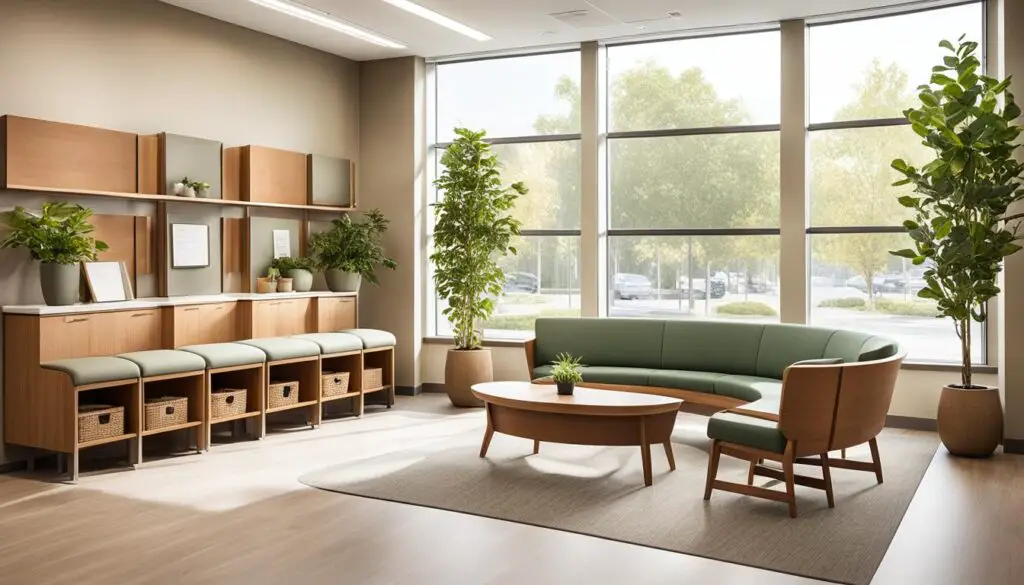
“Investing in comfortable and durable furniture for clinics is more than just aesthetics; it contributes to the overall patient experience and staff satisfaction. Ergonomic seating ensures optimum comfort and support, while durability guarantees a long-lasting investment. By incorporating elements of biophilic design, clinics can create environments that connect patients and staff to nature, enhancing their well-being.”
Adequate Lighting
Good lighting is essential for creating a well-functioning and inviting clinic environment. In healthcare spaces, proper lighting design goes beyond mere illumination. It plays a vital role in promoting patient well-being and enhancing the overall atmosphere. When considering clinic lighting design, there are two key factors to keep in mind: natural light and adjustable lighting options.
Natural light in healthcare spaces: Incorporating natural light into clinic spaces has numerous benefits. Natural light has been proven to improve mood, enhance productivity, and reduce stress levels. Exposure to natural light has a positive impact on patients and can speed up the healing process. For healthcare facilities, it is important to maximize the use of natural light by strategically positioning windows and skylights.
“Natural light creates a connection to the outdoors, providing a sense of calm and well-being.”
By incorporating elements like large windows and light wells, clinics can invite ample natural light, creating a warm and welcoming ambiance. Natural light also offers cost-saving benefits by reducing the need for artificial lighting during daylight hours. Additionally, it can improve energy efficiency and sustainability efforts within the clinic space.
Adjustable clinic lighting: In addition to natural light, adjustable lighting options are crucial for creating a comfortable and adaptable environment. Different areas within a clinic require varying levels of lighting, depending on their function. For example, examination rooms need brighter, task-oriented lighting, while waiting areas may benefit from softer, more relaxing lighting.
Adjustable lighting fixtures, such as dimmers or tunable LED lights, allow healthcare professionals to create the desired atmosphere and meet the specific needs of each space. This flexibility enables clinics to cater to different activities, optimize patient comfort, and create a soothing environment for patients and staff.
Importance of Clinic Lighting Design
Proper clinic lighting design has a significant impact on patients, staff, and overall clinic functionality. With the right lighting approach, clinics can:
- Promote relaxation and reduce anxiety for patients
- Enhance visibility and accuracy for medical professionals during examinations
- Create a warm and inviting atmosphere
- Improve energy efficiency and sustainability efforts
With the right combination of natural light and adjustable lighting options, clinics can strike a balance between functionality, aesthetics, and patient well-being.
| Benefits of Adequate Lighting: | 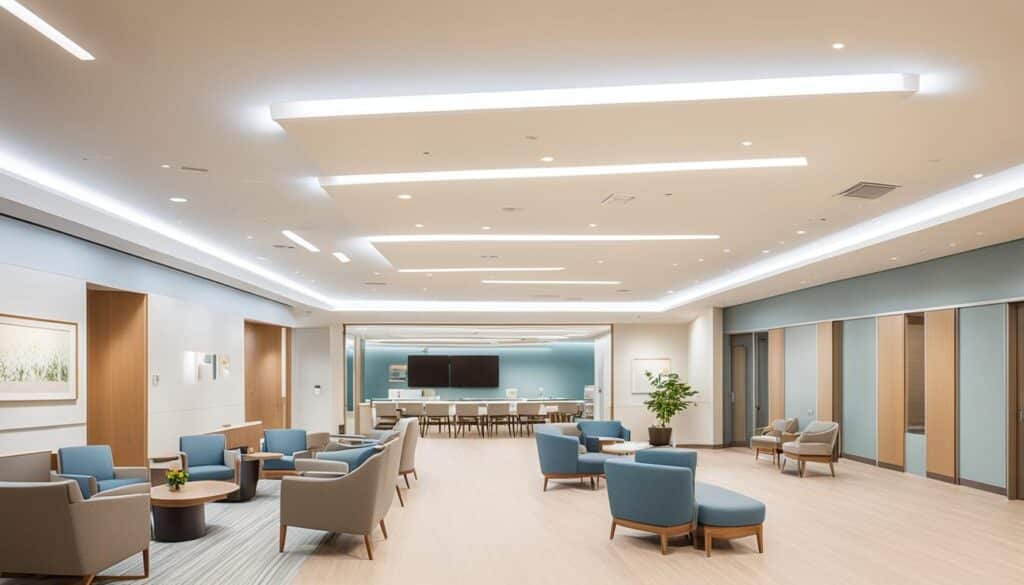 |
|---|---|
| Promotes patient well-being and healing | Makes the clinic space more inviting |
| Enhances visibility for medical professionals | Reduces energy consumption |
| Creates a soothing and comforting atmosphere | Improves clinic’s sustainability efforts |
Thoughtful Art and Décor
Incorporating art and décor into healthcare spaces has a profound impact on the ambiance and overall atmosphere of a facility. By carefully selecting art pieces and décor that reflect a calming and positive theme, healthcare spaces can create a welcoming and uplifting environment for patients, contributing to their overall well-being.
Art has a unique ability to evoke emotions and create connections. Nature-inspired art, such as paintings or photographs of serene landscapes or vibrant flora, can bring elements of the natural world into the clinic space. These pieces can evoke a sense of tranquility and serenity, helping to reduce stress and anxiety in patients.
Inspirational quotes displayed through wall decals or framed prints can have a profound effect on patients’ mental well-being. Positive affirmations and motivational messages can provide a sense of hope and encouragement, creating an optimistic environment that fosters healing and recovery.
Furthermore, incorporating art and décor that represents the local community can help patients feel more connected and comfortable in the healthcare space. Displaying artwork created by local artists or featuring landmarks and cultural references specific to the community can create a sense of familiarity and belonging, enhancing the overall experience for patients.
“Art is not what you see, but what you make others see.” – Edgar Degas
Community-oriented clinic design goes beyond aesthetics and creates a space that reflects the values and identity of the local community. By incorporating art and décor that is meaningful to the community, healthcare facilities can establish a stronger connection with patients, promoting a sense of inclusivity and trust.
Example of Art in Healthcare Spaces
Here is an example of how art can be incorporated into a healthcare space:
| Artwork | Description |
|---|---|
| A nature-inspired mural covering an entire wall, depicting a peaceful forest scene with sunlight streaming through the trees. The colors and imagery create a calming and soothing atmosphere for patients waiting in the reception area. |
In this example, the artwork creates a sense of tranquility and offers a connection to the natural world. It serves as a focal point, captivating the attention of patients and providing a respite from the clinical surroundings.
Incorporating thoughtful art and décor not only enhances the visual appeal of healthcare spaces but also contributes to the well-being of patients. By creating a welcoming and positive atmosphere, healthcare facilities can foster a sense of comfort and healing for all those who enter their doors.
Efficient Storage Solutions
When it comes to creating a functional and aesthetically pleasing clinic environment, efficient storage solutions play a crucial role. Proper organization and accessibility of medical supplies, paperwork, and equipment contribute to the overall professionalism and tidiness of the clinic space, ensuring a smooth workflow for both staff and patients.
Investing in clinic storage organization not only enhances the visual appeal of the clinic but also improves efficiency and productivity. With well-designed storage systems in place, healthcare professionals can easily locate and retrieve necessary items, saving valuable time and minimizing disruptions during patient care.
Benefits of Organized Clinic Solutions
An organized clinic promotes a sense of order and cleanliness, creating a positive impression and instilling confidence in patients. When medical supplies and equipment are stored efficiently, healthcare professionals can quickly access them, ensuring seamless workflow and effective patient care.
“Efficient storage solutions in a clinic go beyond aesthetics. They streamline operations, enhance efficiency, and contribute to a better overall patient experience.”
By implementing organized clinic solutions, healthcare facilities can also reduce the risk of errors and improve patient safety. Well-labeled storage areas and clear inventory systems minimize the chances of misplaced or expired items, ensuring that healthcare providers have access to safe and reliable medical supplies.
Medical Supply Storage Tips
Here are some tips to optimize medical supply storage in a clinic:
- Categorize and sort supplies based on functionality and frequency of use.
- Utilize storage bins, shelves, and cabinets to maximize space and keep items properly organized.
- Label all storage areas clearly to facilitate easy identification of supplies.
- Establish a regular inventory management system to monitor stock levels and expiration dates.
- Consider implementing a barcode or RFID tracking system for efficient supply management.
By following these tips, healthcare professionals can maintain a well-organized and efficient clinic storage system, ensuring that essential medical supplies are readily available when needed.
Comparison of Different Clinic Storage Solutions
| Storage Solution | Advantages | Disadvantages |
|---|---|---|
| Open Shelving | Easy access to supplies Durable and versatile |
Exposes supplies to dust and contaminants Lacks visual appeal |
| Lockable Cabinets | Secure storage for sensitive items Keeps supplies organized and protected |
Limited visibility of supplies Requires keys for access |
| Mobile Carts | Portable and flexible storage solution Allows easy transport of supplies |
May occupy valuable floor space Requires regular maintenance |
Choosing the right storage solution depends on the specific needs and requirements of the clinic. A combination of different storage solutions may be ideal for accommodating various supplies and optimizing space utilization.
Implementing efficient storage solutions is crucial for maintaining a well-organized clinic environment. By investing in proper storage systems, healthcare facilities can enhance productivity, improve patient care, and create a professional and welcoming atmosphere.
Conclusion
Biophilic design is a groundbreaking approach to healthcare facility design that prioritizes the integration of nature. By incorporating natural elements such as abundant natural light, soothing colors, and natural materials, biophilic design creates healing environments that foster patient healing and well-being. The use of biophilic design principles, combined with thoughtful layout, comfortable furniture, adequate lighting, and inspiring art and decor, contributes to a positive and welcoming clinic space for both patients and staff.
Healthcare facilities that embrace biophilic design see remarkable benefits. Studies have shown that exposure to nature, even in simulated forms, can reduce stress, improve mood, and enhance overall recovery rates in patients. Patients in clinics with biophilic design elements experience reduced anxiety and heightened comfort levels. Additionally, these design choices can positively impact staff members, creating a more serene and conducive work environment.
Integrating nature into healthcare facilities through biophilic design is not a mere aesthetic choice; it is a powerful tool for enhancing patient outcomes and overall satisfaction. By incorporating nature in tangible and meaningful ways, healthcare facilities can revolutionize the healing experience, supporting patients on their journey to wellness. Biophilic design is more than just a trend; it is a transformative approach that harmonizes nature and healthcare, ultimately promoting patient healing and well-being.
FAQ
What is biophilic design?
Biophilic design is a concept that focuses on integrating nature into healthcare facilities to create healing environments. By incorporating natural elements such as plants, natural light, and calming colors, biophilic design aims to improve patient healing and well-being.
How does biophilic design impact patients and staff?
Biophilic design in healthcare facilities has a positive impact on both patients and staff. By creating healing environments that mimic nature, biophilic design promotes patient healing, reduces stress and anxiety, and improves overall well-being. It also enhances the working environment for staff, increasing productivity and job satisfaction.
What is the importance of functional layout and flow in a clinic?
A functional layout and optimized flow in a clinic contribute to a more organized and pleasant environment for both patients and staff. It ensures efficiency, minimizes congestion, and provides a better patient experience. Considerations such as the placement of reception areas, waiting rooms, examination rooms, and staff workstations are made to achieve this.
How do calming color schemes affect the clinic environment?
Calming color schemes, such as soft blues, greens, and neutrals, create a relaxing environment for patients. These colors reduce anxiety and promote a sense of tranquility, particularly in waiting rooms and consultation spaces. They greatly impact the mood and atmosphere of a healthcare facility.
What should be considered when choosing clinic furniture?
When choosing clinic furniture, it is important to invest in high-quality, comfortable, and durable pieces. Ergonomic seating for patients and staff should be considered, along with furniture that is easy to clean and maintain. Incorporating elements of biophilic design, such as natural wood accents or potted plants, can also add warmth and a connection to nature within the clinic space.
How does lighting affect the clinic environment?
Good lighting is essential for creating a well-functioning and inviting clinic environment. A combination of natural light and artificial lighting should be considered to ensure the space is well-lit. Adjustable lighting options can help create the right ambiance for different areas within the clinic, accommodating various activities and creating a comfortable atmosphere.
What role does art and décor play in a healthcare facility?
Incorporating art and décor that reflects a calming and positive theme significantly contributes to the ambiance of a healthcare facility. Nature-inspired art, soothing landscapes, or inspirational quotes create a welcoming and uplifting atmosphere for patients. Personal touches such as local artwork or community-oriented décor help patients feel more connected to the clinic space.
Why is efficient storage important in a clinic?
Maintaining a clutter-free and organized clinic environment is essential for functionality and aesthetics. Investing in efficient storage solutions helps keep medical supplies, paperwork, and equipment neatly organized and easily accessible. Well-designed storage contributes to the overall professionalism and tidiness of the clinic space.
How does biophilic design improve patient healing and well-being?
Biophilic design integrates nature into healthcare facilities, creating healing environments that promote patient healing and well-being. The use of natural elements such as plants, natural light, and calming colors reduces stress, improves mood, and enhances the overall patient experience. Nature has been shown to have a positive impact on human health and well-being.
Source Links
- https://www.houseandgarden.co.za/design/trends/lighting-trends-that-illuminate-our-changing-relationships-with-lights-in-our-homes-378a22fa-0e39-4059-9071-8904acc15520
- https://www.wallpaper.com/architecture/office/morgan-north-new-york-usa
- https://hometrendhub.com/enhance-your-clinic-space-with-inspiring-interior-design-ideas/



